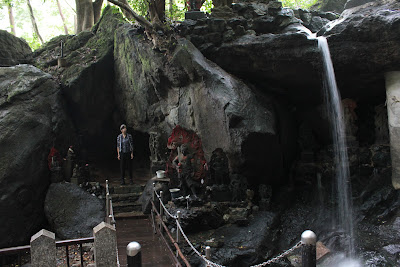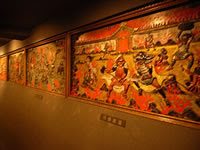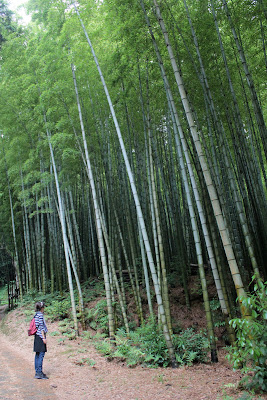Anddd we got to Hiroshima! But the path there was tough. A typhoon was approaching and it was raining like crazy- we got lost on the streets of Hakata on the way to find the station in the beating rain and thunder... arriving at the station soaked having missed the train also. It was one of the few moments I had my low- frustrated, unhappy and miserable about being cold and not being where we planned to be. Good thing about JR pass though since you can just hop on the next train- we changed our wet clothes and shoes and arrived in Miyajima just a few hours later.
そしてーーー広島に到着!ここまでの道のりが大変だった。台風が近づいていたため、大雨:そんな中、博多の道ばたで迷子になっていたのは私たち姉妹。駅が見つからないために、叩き付ける雨の中と雷の中でびしょぬれになり…あげくのはてにやっと駅に着いたら電車も逃してた。個人的にはこの瞬間が旅でのローポイント。寒くてびしょびしょでみじめでイライラ…でも、ここでJRパスのいいところの登場。ただ単に次の電車に乗ればいいだけだった。服を着替え、靴を履き替え、予定していた数時間後に宮島に到着。
A treat waited us at the hostel! A lovely cheery woman were there to greet us and had a perfect plan for us wanting to explore Miyajima. First, we went to get dinner near the ferry station for miyajima. Yummy hiroshima style okonomiyaki (my favourite food for yeaaaars) with noodles and many other delicious ingredients made our stomachs and spirit happy :) Then we took a boat....
雨が降らないと虹はでないというけど、ホステルに着いたらまさにそんな感じだった。とても明るい素敵なお姉さんが私たちを迎えてくれて、宮島を効果的に楽しめるとっておきのプランを教えてくれた。まずは、宮島へのフェリー乗り場の近くで腹ごしらえ。メニューはもちろん、広島風お好み焼き(長年の大好物)!おそばや野菜や色々入っていて、やっぱりおいしい。おなかも心も大満足:)その後はボートに乗って…
....to enjoy Miyajima by night. The forecast had predicted a typhoon, but it was a calm night and the island was deserted. The reflection of the gate was so beautiful, and I was so happy to be visiting the place I had always wanted to visit. I had come to Hiroshima with a class trip when I was in 10th grade, but unfortunately then too, our visit to Itsukushima Shrine was canceled due to a big typhoon.
…夜の宮島を楽しみにいった。天気予報は台風っていっていたけれど、小雨だけで人もいなく、本当に静かな夜。鳥居が水に映されている様子は本当に綺麗で、やっと、ずーっと訪れたかったところにいることを実感し、幸せいっぱい。高校1年のときにクラス旅行で広島に来たが、そのときも運悪く台風で、厳島神社は取り消しになってしまっていけなかったから。
We went to a hotel on the island that had a huge bath... that visitors could also use. Using the onsen after a wet, long, rainy day felt like heaven, and when we came out, it was about the time the waters hit high tide.
On the way back with the last ferry, we came across this cute scene- a deer mom&baby sleeping outside the police station. Probably the safest place to sleep on the island ;)
最終フェリーまでの間、宮島にあるホテルの温泉に行って一日の疲れをとった。長ーく、雨ばっかりで、びしょぬれになった一日の終わりの温泉はまた格別で、すっかりリラックスして外へでたら、ちょうど満潮の時間。
フェリー乗り場への道では、こんな可愛い場面にも出くわした:シカの親子が警察署の前で寝ているの。島で一番安心して寝れる事は間違いなし;)
最終フェリーまでの間、宮島にあるホテルの温泉に行って一日の疲れをとった。長ーく、雨ばっかりで、びしょぬれになった一日の終わりの温泉はまた格別で、すっかりリラックスして外へでたら、ちょうど満潮の時間。
フェリー乗り場への道では、こんな可愛い場面にも出くわした:シカの親子が警察署の前で寝ているの。島で一番安心して寝れる事は間違いなし;)
We had to leave here as the ferry came to pick us up, but I hope the couple left with not too bad impressions of Japan...
フェリー乗り場では、すべての貴重品(パスポート、お金、チケット…本当に全部!)の盗難にあってしまったポーランド人のカップルにも遭遇。日本でこんなことが起きるにもびっくりしたけど、日本といえど、観光地でそこまで貴重品を置きっぱなししていた彼らにもびっくり。宮島でこんな事態が起きた事さえ初めてだったものだから、他に英語ができるホテルの従業員が来るまでの間、警察と彼らの通訳に立候補。かわいそうに、二人は何もなくてどこへも行けなくて、その晩は宮島で事情聴取のため残らなきゃいけなかった。キャンプ用のギアを持っていたけど、台風の中野宿なんてひどいと思い、警察にもせめて屋根があるところを貸してあげてとお願いしたけれど、無理の一点張りだった。こういうときに、日本の真面目なルールに従う姿勢が強すぎて、逆に正しくないんじゃないかと思ってしまった。最終フェリーのお迎えが来たので、私たちの出番はそこまでだったけれど、その後ポーランド人カップルが、日本の印象が悪い状態のまま帰ってないことを願うけど…
Next morning, we came across another and many many deers! And made our way back to Itsukushima Shrine, this time to enter it and see it in daylight. The weather made foggy clouds that swept inbetween the greens and the shrine... creating a really mysterious but beautiful feel to it, and we enjoyed the serene atmosphere...
次の朝また宮島にいくと、夜よりたくさんのシカが出迎えてくれた。朝に来た理由は、もちろん、厳島神社に入りたいから。天気は小雨で、もやを作っていたけど、それが緑と神社にも乗っかっているとすごく神秘的で綺麗な雰囲気を作っていて、味わいがいがあった。本当に息をのむほどの美しさ。
But of course made sure to have fun and be silly when we found this....
けどもちろん、下のようなやつを見つけると、ちょっとふざけてみるのも私たち二人だから…
けどもちろん、下のようなやつを見つけると、ちょっとふざけてみるのも私たち二人だから…

While exploring Miyajima, we also coincidentally came across deer baby being born! It was a magical moment, seeing this creature new to this earth, trying and succeeding to take its first steps. Sara and I both watched it in silence.
その後宮島を散策していたのだけれど、偶然にも、子鹿が生まれる瞬間に立ち会ってしまった。地球に来てすぐのこの生き物が、一生懸命最初の数歩を歩こうとする姿は本当に奇跡的で特別な瞬間だった。二人で、沈黙の中、見守った。

Then we also came across adult deers, totally grown up to be living together with human, peeking into a restaurant for lunch time :)
帰り際会ったのは、もうすっかり人間の世界に慣れた大人のシカ。ランチタイムに合わせて、レストランの中をチェック:)
帰り際会ったのは、もうすっかり人間の世界に慣れた大人のシカ。ランチタイムに合わせて、レストランの中をチェック:)

























































